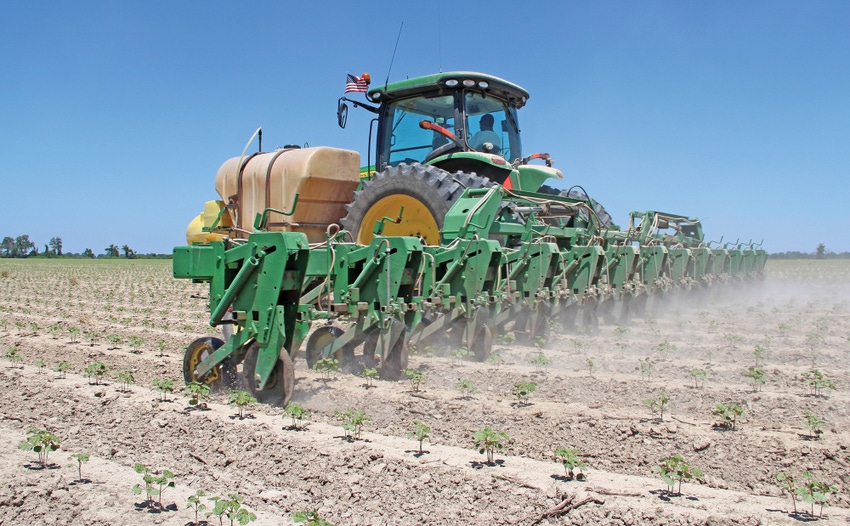
Early germinating pigweed can produce a seedhead when the plant is only three inches tall. This survival characteristic of the weed can create some management issues in weed control.Don't forget that the bottom line for pigweed doesn't change, according to University of Arkansas weed scientist Ken Smith. Take them out at every opportunity to reduce the seedbank.
June 11, 2012

The warm, then cold, followed by dry, spring seemed to be a worse-case scenario for pigweed management. However, it seems that overall, we have some pretty clean fields, but a larger number of “problem” fields.
We all realize soil residual herbicides require moisture for activation, and many fields simply got no rain following planting and herbicide application. But even in dry conditions, either the preplant and preemergence herbicides worked better than expected, or it was too dry for pigweeds to germinate in the top half-inch of soil. It is probably a little of both coupled with an increase in LibertyLink cotton and soybeans that has allowed some escapes to be controlled postemergence.
I have never met a farmer who didn’t think he was behind schedule and felt his “to do” list was longer than “can do” ability. This may come with the territory of working with and/or around Mother Nature, growing seasons and agriculture. But we may not be as far behind as it seems – seldom do we have cotton squaring by June 1 in extreme north Arkansas as we have this year.
Poll: Pigweed: did you make progress this year?
The early warm weather allowed pigweed to germinate prior to most of us getting into the field with a residual herbicide and certainly allowed for some grown-up turnrows. Unfortunately, the normal hectic schedule of getting everything planted and sprayed in the field pushed control of these early germinators to the back burner.
The photoperiod sensitivity of pigweed is extremely evident in these early germinators. Some started to produce a seedhead when they were no more than three inches tall. This is but another survival characteristic of pigweed, and the longer nights triggered reproduction mechanisms within the weed. Obviously, this mechanism evolved to insure seed production and survival of the species when plants germinated late in the summer.
Several plant species respond to photoperiods, but few respond stronger than pigweed. Most plants require some maturity prior to producing a seedhead even under periods of long nights. It seems pigweed almost comes out of the ground with a seedhead under these conditions. We don’t know a lot about the seed production potential of these little weeds with seemingly out of proportion seedheads, but certainly they can produce seed and add to the soil seedbank.
My observations have been that there are many more male than female plants in the early germinating weeds with female plants producing seedheads much later than males. So, most of those really early flowering plants were males that do not contribute to the seedbank. Our work on pigweeds that germinate and grow during the summer indicate that viable seed are often found in seedheads no longer than one inch. However, it seems the early germinators mature much slower, and I found no viable seed in seedheads shorter than six inches.
One question earlier this year was if the plants that produced seedheads when they were no more than three inches tall would mature and die or if they would continue to grow. Most of us realize by now, they have reverted to vegetative growth and have continued to grow. They will produce many more seed in the next few seedheads than in the original small one. This sounds like good news – bad news. The good news is that we have more time to control these early germinators after seedhead formation, and the bad news is that this time has expired, and these must be managed soon.
We have placed a tremendous effort toward reducing the pigweed seedbank over the past two years, and it is beginning to pay off. There are fewer weeds than ever before in fields that have been kept clean for the past two years. This was really emphasized a few days ago when I was talking with a co-worker from another state. When asked how his plots were looking, he said it was hard to tell because he did not have enough weeds to get a true evaluation. He had been establishing plots on a farmer field over the past two years, but this year had moved the plots to the other side of the field.
It seems the farmer had been on a zero tolerance program for the past two years and not allowed any weeds to produce seed. My researcher friend indicated there were plenty of weeds over on the side of the field he had previously used for research plots, but the new plot area was too clean to get good evaluations on herbicides.
We are also looking forward to reducing our hand chopping costs in those fields we have kept clean for the past year or two. Surely, we cannot allow the seedbank to be increased by these early germinators on turnrows. I realize schedules continue to be hectic, but we may not be as far behind as it seems, and it may be time to break out the hooded sprayers or light tillage equipment and take these out before they produce a few million seed for us to contend with later.
You May Also Like



